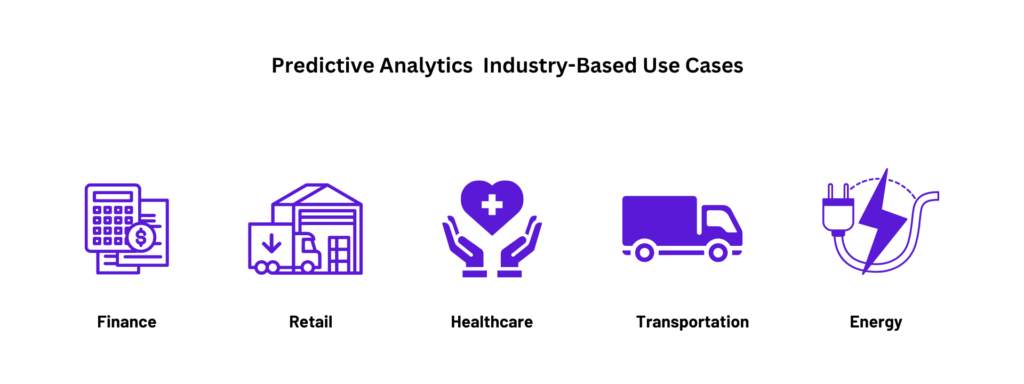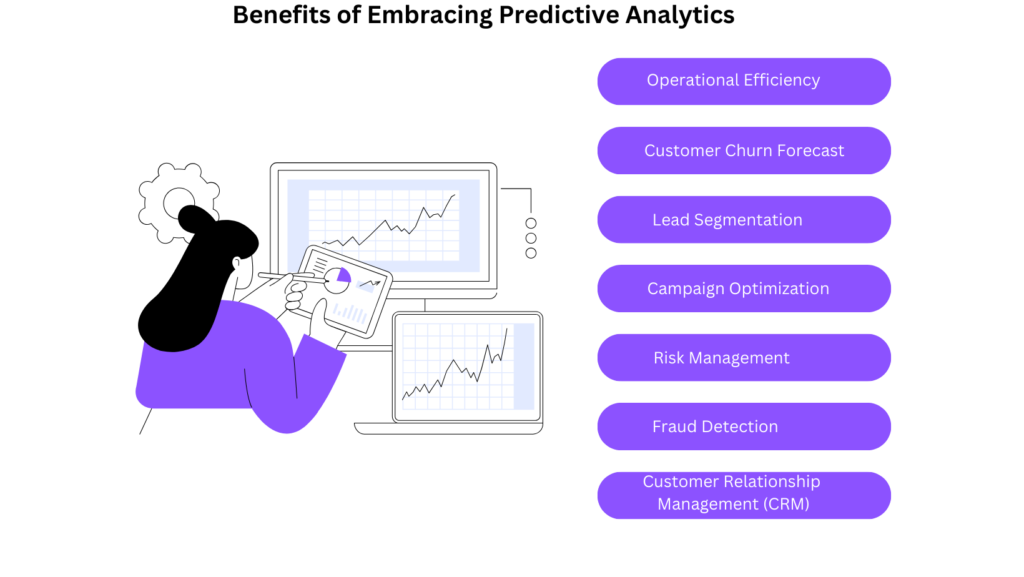In the realm of business, an abundance of data is at your disposal, offering a valuable resource for informed decision-making. Through the application of predictive analytics in business, the analysis of historical data facilitates the creation of models, enabling accurate projections of future outcomes. This strategic approach not only grants insights into past successes and failures but also empowers you to implement necessary changes, ensuring the thriving success of your business.
Predictive Analytics in Business: Why Should You Invest?
Investing in predictive analytics for business can significantly influence the success of any organisation, offering a range of advantages. Here are some benefits of allocating resources to predictive analytics solutions in the business context:
1. Making Data-Driven Decisions
By utilising real-time and historical data, predictive analytics generates insights and forecasts for the future. Organisations can adopt data-driven decision-making, relying on quantitative analysis rather than solely on intuition or guesswork, to make well-informed decisions.
2. Improved Understanding of Consumer
Predictive analytics can analyse customer data, encompassing purchase history, browsing habits, and demographics, to construct a comprehensive profile of customer preferences and behaviours. This enables businesses to tailor marketing initiatives, refine client segmentation, and deliver targeted offers, ultimately elevating customer satisfaction, enhancing customer retention, and increasing sales.
3. Risk Reduction
Utilizing predictive analytics in business strategy enables the identification of potential risks and threats across various business domains, including fraud detection, credit risk assessment, supply chain disruptions, and cybersecurity. Businesses can proactively identify and mitigate risks, leading to reduced financial losses, fraud prevention, safeguarding critical data, and ensuring operational continuity through the application of predictive analytics.
4. Better Planning and Forecasting
Predictive analytics empowers organizations to make more precise predictions about future trends, demand, and market behavior. This allows for strategic resource allocation, optimization of inventory levels, and alignment of production schedules with data-driven insights.
It is essential to emphasize that successful implementation of predictive analytics requires the proper data infrastructure and skilled experts with the necessary knowledge and experience. This leads us to our next topic of exploration: the application of predictive analytics in various industry verticals.
Predictive Analytics Business Cases: Industry-Wise Examples
Various industries have recognized the significance and potential of predictive analytics in enhancing their business operations. Below are notable examples of predictive analytics business applications in different industries:

1. Finance
In the finance sector, predictive analytics proves to be a formidable tool for real-time detection of fraudulent transactions. Through the analysis of historical transaction data, financial organisations can develop models that identify patterns indicative of fraudulent behaviour, effectively preventing future incidents. Given the reliance on predictive analytics for fraud detection, credit scoring, and investment forecasts, it is evident that this technology is essential for any financial institution striving to maintain a competitive edge.
2. Retail
In the realm of retail, predictive analytics stands as a powerful asset for streamlining operations and enhancing profitability. Through the anticipation of customer demand, merchants can strategically manage their inventory, ensuring the availability of the right products while simultaneously minimising waste and controlling costs. The implementation of tailored marketing campaigns, guided by predictive analytics, enables retail businesses to focus their advertising endeavours on customers with the highest probability of making a purchase, thereby enhancing their return on investment.
3. Healthcare
In the healthcare sector, predictive analytics plays a pivotal role in leveraging patient data to foresee outcomes, identify individuals at risk of certain ailments, and allocate resources more efficiently. For instance, hospitals can utilise predictive models to anticipate the probability of patient readmission within a defined timeframe. This proactive approach aids hospitals in cost reduction and enhances overall patient outcomes. Read this blog to understand how data analytics in healthcare contributes to cost-effectiveness.
4. Transportation
In the realm of transportation, predictive analytics proves instrumental in enhancing route planning, identifying maintenance requirements, and effectively managing fleets. Logistics organisations can leverage predictive analytics solutions for businesses to optimise delivery routes and foresee potential delays by analysing past transportation data, weather patterns, and other relevant variables.
5. Energy
In the energy sector, companies can minimise energy wastage through demand forecasting based on historical consumption trends, adjusting production accordingly. Predictive analytics solutions enable the pre-analysis of equipment faults and the optimization of energy usage. By leveraging data effectively, firms can achieve cost savings, minimise downtime, and enhance overall operational efficiency.
The Business Benefits of Embracing Predictive Analytics
Embracing predictive analytics provides numerous advantages for businesses, contributing to the optimization of processes and fostering overall business growth. Let’s delve into a detailed examination of the benefits that adopting predictive analytics brings to business strategy.

1. Operational Efficiency
Predictive data analytics can seamlessly integrate into various internal touchpoints to enhance day-to-day operations. Managers can allocate resources to new initiatives with confidence, relying on near-precise estimates of when ongoing work will be completed.
2. Customer Churn Forecast
Creating a churn forecast involves identifying the indicators that precede customers’ cancellation requests and assessing the likelihood in each scenario.
Predictive models can be employed to analyse data such as customer service quality, customer satisfaction, and churn rate, helping to identify the factors that influence cancellations.
3. Lead Segmentation
By conducting thorough research and employing data and machine learning, you can create segmented groups, forecasting which leads require meticulous attention. This approach provides insights into the estimated time, cost, and deliverables of a machine-learning project.
4. Campaign Optimization
Leverage your entire marketing campaign history to anticipate improved future results.
Utilize predictive analytics in project management to identify the most effective channels for each content piece, the optimal language for specific target demographics, and other factors that impact consumer acceptance.
5. Risk Management
Predictive analysis proves to be a direct asset in the realm of risk management.
Isn’t decision-making significantly facilitated when there is a clear understanding of both the dangers and opportunities that lie ahead?
As a result, whether evaluating a customer’s credit risk or examining the potential consequences of an investment, foreseeing the probability of profit or loss stands out as a pivotal distinguishing factor in contemporary data analysis.
6. Fraud Detection
Organizations can employ analytical methods to Defect patterns of fraud and prevent security breaches.
Given the growing emphasis on cybersecurity, more businesses are prioritizing the identification of vulnerabilities and timely detection of anomalies to mitigate potential damage.
7. Customer Relationship Management (CRM)
In CRM strategies, predictive models prove valuable for comprehending clients at various stages of their life cycle and purchasing journey.
Abundant data allows the construction of multivariate models, enabling the assessment of a broad spectrum of potential connections between behaviors, profiles, purchase histories, interactions, and consumer perceptions.
Possessing this essential information enables the transformation of consumer relationships through tailored content, promotions, and offers.
The Business Benefits of Embracing Predictive Analytics
Despite its considerable potential, predictive analytics comes with several pitfalls that businesses need to be cautious about. Among the primary challenges encountered during implementation are:
1. Lack of Domain Expertise
Achieving success with predictive analytics hinges on a thorough understanding of the context and nuances within the business domain. Without adequate domain knowledge, evaluating results, validating models, and making informed decisions based on forecasts becomes challenging.
2. Insufficient Data Quantity
To identify meaningful patterns and generate reliable predictions, predictive models require an ample amount of data. If the dataset is limited or lacks diversity, predictions may be inaccurate, as it may not adequately capture the complexity of the issue.
3. Poor Data Quality
The precision and quality of data play a pivotal role in the effectiveness of predictive models. If the data used for analysis is deficient, inconsistent, or erroneous, it significantly affects the accuracy and reliability of forecasts.
4. Bias and Discrimination
Predictive models may unintentionally perpetuate biases present in the training set, leading to discriminatory outcomes. Biassed data or model design, particularly in areas like recruiting, lending, or criminal justice, can result in unfair decisions.
5. Lack of Continuous Monitoring
Consistent performance of predictive models over time requires continuous monitoring. Regularly monitoring models is crucial to preventing a decline in accuracy, especially when there are changes in the underlying data or business context.
6. Changing Data Patterns
Predictive models are built on historical data, assuming that the observed patterns from the past will persist into the future. Nevertheless, the model may become obsolete or yield inaccurate predictions if there are alterations in the underlying patterns.
Kickstart the Predictive Analytics Journey for Your Business With Digiatto IT services
Given the substantial economic value they offer, predictive analytics models are poised to play an increasingly vital role in company processes in the future. Although these models may not be flawless, their significant benefits for both SMEs and large-scale organizations are undeniable. Predictive data analytics enables organizations to proactively address various areas.
Embark on your journey to learn predictive analysis and set up your product and business for success by seeking guidance and hiring a seasoned software development company such as Digiatto IT Services.
Utilize our top-tier data analytics solutions to access valuable insights and guide data-driven decisions for your business. Contact us today to explore more about our services and discover how we can contribute to the growth of your business.
FAQ
Q. What is predictive analytics in business?
Predictive analytics in business involves employing diverse statistical techniques, including automated machine learning algorithms, deep learning, data mining, and artificial intelligence (AI), to develop predictive models. These models extract insights from datasets, discern patterns, and generate predictive scores for a variety of organizational outcomes.
Q. Can you provide instances of predictive analytics applications in business?
Predictive analytics in business, once considered a specialised tool for a select few, is now widely utilised across various industries. Here are examples of industries where predictive analytics is applied:
- Sports
- Retail
- Health
- Weather
- Financial Modelling
- Insurance and Risk Assessment
- Social Media Analysis
- Supply Chain Management
Q. How do predictive analytics help businesses?
Predictive analytics offers substantial benefits to businesses:
- It predicts future events by analysing historical data and employing statistical models, facilitating informed decision-making.
- It enhances cost-effective inventory management, precise demand forecasting, and overall cost reduction.
- Predictive analytics improves customer insights, enabling targeted marketing strategies and elevating customer retention efforts.
- It assists in identifying potential fraud or risks, allowing for proactive preventive measures.
- It contributes to streamlining operations, improving efficiency, and identifying areas for potential process optimization.



Pingback: What is predictive analytics? Dispelling some common myths - HealthSaaSPro